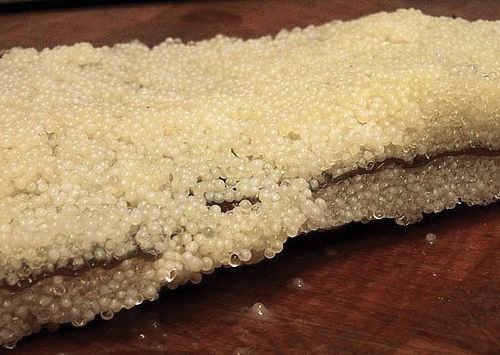
With this year’s herring season underway, health authorities are recommending caution to reduce the risk of illness from eating herring eggs.
Herring eggs are an important traditional seafood for many First Nations people in B.C., providing cultural, nutritional, and economic benefits. However, in March 2018 a small group of people contracted Vibrio cholerae infections as a result of eating herring eggs harvested in the French Creek and Qualicum Bay areas of Vancouver Island. This illness can cause intestinal symptoms and fever, particularly in people with compromised immune systems (see backgrounder below for more information).
There were no reported illnesses with this bacteria following consumption of seafood in 2019 and none have been reported so far this year. However, to reduce risk the First Nations Health Authority recommends the following key steps before, during, and after harvesting herring eggs.
Before Harvest:
• Sanitize totes and equipment used for harvest and storage prior to use with a sanitizing agent. Include any surfaces seafood may come in contact with, such as rakes and surfaces within the vessel.
• Sanitizing options:
o 200 ppm peracetic acid, or
o 200 ppm quats (quaternary ammonium) solution or
• Environmentally safe disinfectant options to avoid introducing chemicals into the environment:
o steam or hot water rinsing, cleaning, and sanitizing at temperatures above 70°C (160°F) or
o 1% Virkon aquatic solution, or
• Other recognized sanitizers approved by Health Canada for aquatic environments.
During Harvest:
• Wash hands with drinking-quality water and soap before handling eggs.
• Where possible, rinse eggs using drinking-quality water or use boiled and cooled salt-water to preserve taste (38 g of salt per litre or two heaping tablespoons in four cups is equivalent to seawater). Rinsing helps to reduce some of the bacteria that may be present.
• Use ice made with drinking-quality water to keep eggs cold.
• Place harvested eggs immediately on plenty of ice in a cooler or tote to keep product cold (less than 4°C) and minimize time outside of cold storage. This will prevent bacteria from growing.
After Harvest:
• Keep harvested eggs cold at all times, including during transportation. Refrigerate or freeze as soon as possible. It is important to avoid delays between harvest and refrigeration.
• Wash hands with drinking-quality water and soap before handling eggs.
• Use drinking-quality water in preparing herring eggs.
• Sanitize equipment and utensils used for handling herring eggs.
• Cook herring eggs to an internal temperature of 63⁰C for at least 15 seconds to destroy bacteria. Blanching herring eggs in salted, boiling drinking-quality water will also reduce bacteria levels. To blanch, add eggs to salted, boiling water for one minute, remove and add to chilled, boiled salted water. If not cooking the eggs, be aware that there is always a risk with eating raw seafood.
• Under refrigerated storage at 4⁰C or lower, seafood will have a shelf-life of one to three days.
If you become ill:
Visit your health care provider if you become ill after eating herring eggs with any of the following symptoms:
• diarrhea
• abdominal cramps
• fever
• nausea
• vomiting or
• blood in the stool
For immediate help, call the nurse line at 811, or Drug Poison Info Line at 1.800.567.8911
For more information:
FNHA Environmental Public Health Services, Oyster Bay Office 250-924-6125
Backgrounder – Herring Eggs and Vibrio cholera bacteria
Vibrio cholerae bacteria:
The illnesses caused by eating herring eggs were caused by non-toxigenic Vibrio cholerae non-01/non-0139 bacteria which was found both in ill persons and in herring eggs collected from French Creek and Qualicum Bay in 2018 (but not before or since). This bacteria does not produce cholerae toxin which is responsible for the well-known severe form of Vibrio cholerae illness. The non-toxigenic form of the bacteria has the following characteristics:
• It is a natural inhabitant of the marine and estuarine environment.
• It is not an indicator of poor sanitation or sewage contamination.
• Infections are relatively rare, but when they occur, they include such symptoms as diarrhea, abdominal cramps, fever, vomiting, nausea, blood and mucus of the stool.
• Individuals with less stomach acid (young children, elderly and those taking antacids) and/or with underlying medical conditions (i.e. chronic liver disease, people with a compromised immune system and people with other chronic illnesses) are more at risk.
• Usually the illness is self-limiting and of short duration (less than one week, usually one to three days).
A number of factors affect how Vibrio cholerae bacteria survives and grows in marine environments:
• Environmental conditions, such as nutrient availability, salinity, acidity, temperature, and sunlight.
• Survival strategies that allow for its growth, protection, and persistence, on its own or in association with other marine organisms, such as biofilms, attachment to sediments, and ability to bind to chitin.
• There is evidence suggesting that climate change - including rising temperatures -increases the risk of infections associated with the bacteria.
• The two factors that contribute most to the growth of the bacteria are water temperature above 10⁰C and low salinity seawater. At the time of the March 2018 harvest water temperatures were below 10⁰C, however a relatively high rainfall could have affected different environmental factors, including lowering salinity and increasing nutrient availability.
• Unlike other shellfish monitoring programs that have early warning indicators, there is currently not a single signal or combination of environmental signals that could be monitored to reliably predict the abundance of the bacteria in water.
Resources
• BCCDC Shellfish Harvesting Sites Status Map to identify if an area is open or closed:
http://maps.bccdc.org/shellfish/
• Find more information on Food Safety for First Nations communities

